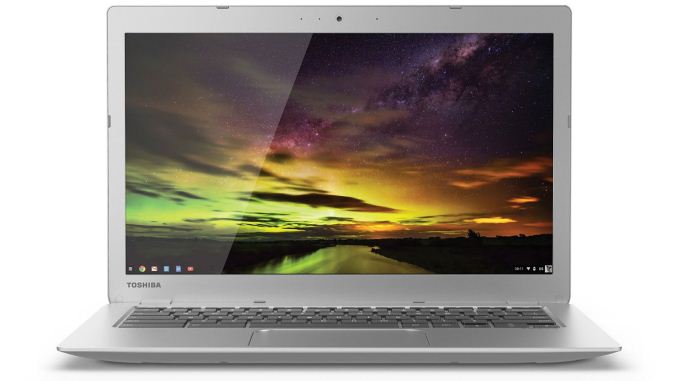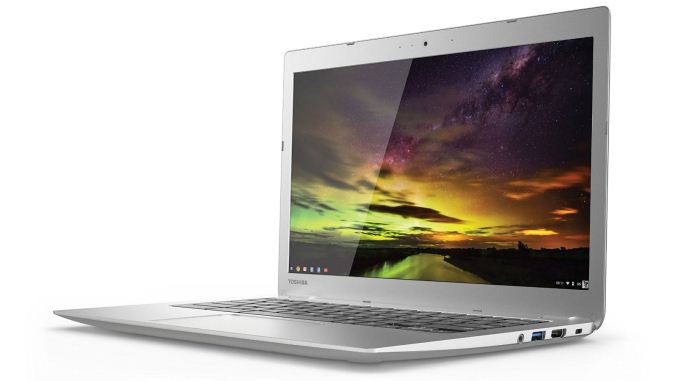Toshiba Chromebook 2: A Feast for the Eyes
by Jarred Walton on February 11, 2015 10:00 AM EST
Toshiba Chromebook 2 with 1080p IPS
We often complain about the effects of the race to the bottom – the race to the lowest possible price, regardless of what effect that has on overall quality. For more than a decade we’ve seen very little in the way improvements in display quality on laptops, with the primary change being the switch from CCFL backlighting to LEDs. In fact, it really wasn’t until the tablet market exploded that we started to see true improvements in laptop displays – or if you prefer, it was roughly around the time that Apple first released their MacBook Pro Retina.
Whatever you want to attribute the change to, there has been an increase in demand for good quality laptop displays, and that in turn has driven down the prices on such displays. Huzzah! We’re still a long way from putting TN panels behind us, but it’s now possible to find good displays in a laptop at price points well below $1000, which is great news. And it’s something that needs to continue to happen, as tablets are pretty much a guarantee that you’re going to get something better than a TN panel with a 250:1 contrast ratio; with tablet performance creeping ever closer to that of budget laptops, you can definitely make the argument for just getting a tablet with a keyboard...but that’s still a tablet with a keyboard rather than a laptop.
Chromebooks basically target that niche where there’s a desire for a true laptop experience, though obviously with some other qualifications. We've covered these before, but the biggest is that users need to be willing to leave behind the world of Windows and move to a new OS, but again with the proliferation of tablets, smartphones, Apple’s OS X devices, and a greater reliance on Internet and cloud-based services, people in general have become far less attached to their OS. Along with that, you need applications to perform everyday functions, with the Google Chrome App Store filling that role.
Chrome OS and the Chrome App Store also gives users the walled garden experience, ensuring that you won’t become a victim of the latest viruses and malware. It’s true that you can get a lot of that with iOS and Android, but Windows users at least have generally rejected that approach. And the Windows software developers are opposed to having a fully curated app store as well – look no further than Valve and their Steam OS initiative to see an example of this. For better or worse, Windows has a legacy of openness, and as the largest share of installed PCs it’s not something easily changed. At the same time, a lot of money ends up being poured into antivirus and antimalware tools, not to mention the support costs, so many are looking for an alternative. They’re saying, “Let Windows be Windows, but give me something easy to use and maintain.” For Google, Chrome OS is that something else.
Getting to the Toshiba Chromebook 2, let’s hit the spec sheet before we go any further. It’s important to note that there are actually three models of the Toshiba Chromebook 2 available, and when we say “Toshiba Chromebook 2” throughout this review we’re specifically referring to the model with the 1080p IPS display that we’re testing, also called the Toshiba Chromebook CB35-B3340. The Toshiba CB35-A3120 is actually the original Toshiba 13” Chromebook and sports a 1366x768 TN display with a Celeron 2955U, while the CB35-B3330 is the same as the model we’re reviewing but with a 1366x768 TN display and 2GB RAM.
| Toshiba Chromebook 2 CB35-B3340 Specifications | |
| Processor | Intel Celeron N2840 Dual-core 2.16-2.58GHz HD Graphics 4 EU GPU |
| Connectivity | 2x2 dual-band 802.11ac (Intel 7260NGW) Bluetooth 4.0 (Intel 7260NGW) |
| Memory | 4GB DDR3L |
| Storage | 16GB eMMC |
| Battery | 3-cell ~10.8V, 3860mAh, 44Wh |
| I/O | 1 x USB 3.0 1 x USB 2.0 HD webcam Dual array microphone HDMI Headphone/mic jack SD Card reader |
| Dimensions | 12.6" x 8.4" x 0.76" / 320 x 213 x 19.3 mm |
| Display | 13.3-inch IPS 1920x1080 |
| Weight | 2.95 lbs. / 1340g |
| Price | $330 MSRP, $329 Online |
Besides the inclusion of a great display – more on that in a moment – the remaining specs are pretty typical of Chromebooks. The processor of choice this time is Intel’s Celeron N2840, a dual-core Bay Trail chip running at 2.16-2.58GHz. The GPU portion of the chip is based on Intel’s HD Graphics architecture, the same architecture in Ivy Bridge and Haswell processors, but with only 4 EUs active. By comparison, the Celeron 2955U has 10 EUs, and they’re clocked higher as well, making the 2955U graphics potentially 2.5-3X faster. Whether or not that ends up being important is something we’ll discuss in our benchmark section.
Other features include two USB ports – one 2.0 and one 3.0 – an SD card reader, and a full size HDMI port. You also get 4GB of DDR3 memory (non-upgradeable) and 16GB of eMMC storage (plus 100GB of Google Drive storage for two years). The battery is a 3-cell 44Wh model rated for up to nine hours of battery life, which is good though not class leading. Compared to Windows laptops, some of the specs might seem a bit limited, but we’re talking about a $329 laptop with a good display, which is something you can’t currently find in the Windows laptop space. (Windows tablets however….)











66 Comments
View All Comments
ezschemi - Wednesday, February 11, 2015 - link
Table on page 1 says:"Intel Celeron N2840
Dual-core 2.16-2.58GHz"
while directly below the text says:
"The processor of choice this time is Intel’s Celeron N2840, a quad-core Bay Trail chip running at 2.16-2.58GHz."
dual core vs quad core. One of them is incorrect.
JarredWalton - Wednesday, February 11, 2015 - link
Fixed. I initially thought it was a quad-core CPU (before doing additional checking), and apparently I wrote that part of the text before I fixed the table. I think I actually had the CPU listed as the N2940 at one point, which is the quad-core part.BrokenCrayons - Wednesday, February 11, 2015 - link
It's nice hardware for Chrome OS, but what worries me is that there are two fundamental problems. The price for what ought to be a budget-friendly, inexpensive throw away device is far too high when compared to cheap Windows-based notebooks like the Stream 11 (which isn't favored in benchmarks in this article, but as those benchmarks are largely Google-based and Google products will invariably see favorable numbers due to bias). In fact, across the board, Microsoft devices have really turned the tables on pricing, seemingly winning the race to the bottom with sub-$100 dollar tablets and that ilk that have greater functionality than any Chrome OS or Android device. In a price- and feature-sensitive market, Google appears to have presently lost the lead.The other problem is fundamental to the Chrome OS design being cloud-centric using Google services. Google isn't a company that's no longer commonly trusted to be a proper caretaker for user data and I often wonder what kind of information about what I'd be doing on any Google product is being sent upstream to be stored for an indefinite time period and then monetized. The general sense I get is that these sorts of trust issues are already a problem (as Google's recent moves to take Glass development in-house and out of the public view where people are being punched in the face for wearing it) and are likely to get more prominent as information security takes a more prominent role that enhances public awareness. It's a perfect storm that's brewing and Google's business model places it at the very heart of the looming controversy.
SM123456 - Saturday, February 14, 2015 - link
The Stream 11 hardware is identical to most entry level Chromebooks using the Intel Celeron N2840 Dual core Atom Bay Trail CPU and 23GB eMMC storage which are also priced $199, but the Stream 11 runs the full browser benchmarks (Google Octane and Firefox Kraken) at half the speed of the identical Chromebooks and about a third of the speed of the $179 Acer C720 Haswell Celeron 2955U Chromebooks. This is nothing to do with the fact that the benchmarks are specified by Google or Firefox - they are both good indicators of overall performance - ie. rendering, video/audio decoding, SSL encryption/decryption, etc as well as Javascript code execution - unlike SunSpider for example which just benchmarks Javascript execution.This is entirely due to the Windows resource hog the system as everything else is identical. The Sunspider pure Javascript benchmarks aren't affected by the Windows resource hog because they don't need much resources, while the full browser function benchmarks are, because they do hog resources - eg. RAM disk swap of virtual memory, use of shared RAM for graphics etc.
AnnonymousCoward - Wednesday, February 11, 2015 - link
No mention of color gamut?16GB is pathetic storage for a laptop. 32GB microSD cards are sold for $14 shipped in retail. Toshiba was literally just trying to save a few bucks. As a consumer, wouldn't you rather pay $335 instead of $330 to have 32GB? I hate it when companies cut corners like this.
The marketing dept was clearly copying Apple with those pictures, adding the diagonal glare line.
JarredWalton - Wednesday, February 11, 2015 - link
Sorry -- I had the images and forgot to include them on the LCD page. I've added another gallery at the bottom of page 3.AnnonymousCoward - Thursday, February 12, 2015 - link
Thanks Jarred! That's commendable that you respond to and address our feedback :)CoreLogicCom - Wednesday, February 11, 2015 - link
It's not storage for the user (unless the user is specifically using Offline capable apps). It's local storage only for the OS. The user is supposed to be 100% network connected and be using the cloud (Google Drive), which itself is 100GB of space.bsd228 - Wednesday, February 11, 2015 - link
you have 2 usb ports and an SD card slot. If you want local storage, it's trivial to add, using one of those tiny form factor usb sticks.AnnonymousCoward - Thursday, February 12, 2015 - link
Ok, the SD slot sounds like a reasonable solution for a decent hard drive.